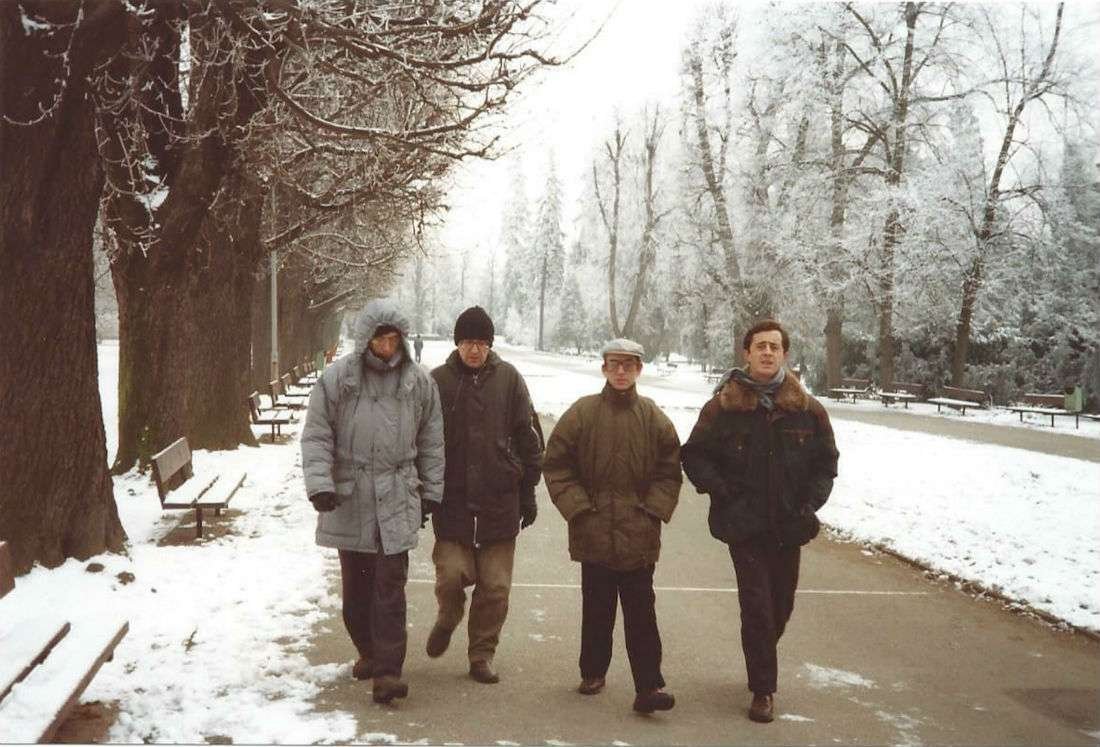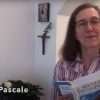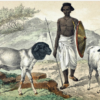
When I knew that I would go to Prague, I started imagining the snow and the distant howl of wolves. In reality, when I went to my first supermarket in Bratislava, the language of the Slovaks sounded like the language of birds to me. When I arrived in Prague one month later by train, a blond child crossed his gaze with mine, and it was as if the Child Jesus of Prague was there, in that lovely creature. It was September 20, 1991.
I had parted from Felipe Rufes that day, and from Antonio Vicente a few days before. They had come to Czechoslovakia before me: Felipe to Olomouc in February 1991; Antonio Vicente to Bratislava, in July of the same year.
When I arrived in Prague from Olomouc, prof. Josef Forbelský, an important Hispanist and translator, was at the station of Holešovice. He accompanied me to Kajetánka University Residence, the first place where I was to stay. We did not go by taxi, as the professor would have liked, but in an ambulance that was there, perhaps waiting for the shift, or for some other reason, because taxi drivers refused. It would take too much time and space to try and explain the reasons for this refusal.
We three missionaries saw each other periodically in one of the three cities. The superior was Felipe, who knew how to combine wisdom with meekness and human warmth, and who never neglected the contact he could have with Luis Sánchez, the first idente missionary who had settled in the Slavic world, more precisely in Poland.
The way had been paved before by the President of the idente missionaries (P. Jesús Fernández) and the General Superior of the women’s branch (María del Carmen García Viyuela). Those first idente trips to the Slavic world were the expression of the dream of the Founder of the Institute and the founding stone of what was to come later.
Thus began the foundation in Czechoslovakia, which soon divided into two republics, Czech and Slovak (1 January 1993).
None of the adventures experienced in these early years had the power to produce any feeling of solitude. No, the feeling of loneliness is not part of the experience of the first idente missionaries to these lands: the presence of Christ, the heavenly Father, the Holy Spirit, Mary, the Founder, the whole Institute excluded that.
Providence was sowing the charism, which started sprouting in this field of mission with small plants that were being born, were growing, and developed. Thus the plant was born of the relations we had with the university world, in Olomouc, Bratislava and Prague: meetings with intellectuals, with poets. The plant of the presence of the missionaries in different faculties was born; the plant of national or international meetings of young people; the plant of the Idente Youth, with summer camps soon being held. The first vocations of missionaries, men and women, came true: the women were first. Some students of the Faculty of Philosophy of Olomouc began to walk the path of the idente charism. Meanwhile, there was an increase in the number of young friends, future idente youths, and the activities of the Idente Youth became more frequent and wide-ranging. Especially in Pilsen, where a dear friend of ours, Pablo Chacón, came to live, at the invitation of the General Superior. It was truly the fulfilment of the parable of the mustard seed.
With the priestly ordination of the author of this article, new horizons opened in the ecclesiastical field. Thus, the plant of the “Institute of the Archbishopric” germinated. The newly-ordained priest had been appointed spiritual director there thanks to a “kidnapping”, taking up the term of the auxiliary bishop of Prague, Mons. František Lobkowicz, now bishop of Ostrava-Opava. With the “Institute of the Archbishopric”, many long-lasting relationships started with young people and teachers. From there arose the vocation of John De Gree, who for many years has now been living in California with his numerous family.
Back in 1993, or perhaps 92, Felipe Rufes had met Antonin Lukeš, who was to be the first idente missionary in the Slavic world. My first contact with Antonin followed Felipe’s description when he had to leave for China: “He is a blond youth, with long hair, shorts and flip-flops, and he comes to mass to this church and he always goes to communion. His name is Tonda. I have proposed a project to him.” That was how I met Antonin. When I saw him, I thought “I’m sure this is him.” I waited for him at the exit door of the church and I told him, in a Czech that Antonín understood only because he was Czech and he could understand it with just a few elements: “Are you Tonda?” He answered: “Yes.” “Do you know Felipe?” “Yes”. “Did he tell you about a project?” “Mmm …” We went directly to a small park nearby. We sat on a bench and I talked to him. Well, I spoke to him or uttered words that were hardly intelligible. I did understand Antonin better, although not well, because I think that in a foreign language it is easier to understand than to speak. Well, Antonin Lukeš is now parish priest in the Parish of the Nativity of Mary, in Prague, where there is a community of three men missionaries.
Thus it was that those tender plants that Providence had sown were growing. In the year 1996, the Three Kings’ procession started in Prague, also in providential circumstances. The procession became a more and more important event, until it actually took root in the Czech Republic and became a popular tradition. In addition, it seems to have inspired this same activity in Poland.
Since the beginning and as years went by, other vocations emerged from the Slovak population: Miloš Miko, Anita Szaboová, Jana Boboková, Michal Koči. A very small seed had been sown, a handful of souls driven by an irrepressible ideal: to fulfil a mission. The superiors had sown a dream, that dream was taking shape and expanding. The idente charism started to become a plant, a tree, extending its branches, and on its branches some nests appeared. It is the many people – many thousands – who have heard of the idente missionaries (previously totally unknown in Czechoslovakia), who have expressed their friendship, who have opened their hearts to the idente message, who have helped the men and women missionaries, who have been participating in our activities, who are in contact, who feel that they are idente (this is the case, for example, of many young people who formed the nucleus of the first Idente Youth in this region and who identify themselves as “idente”). During these years the idente charism has spread in the Parish of the Nativity of Mary, in our relationships with universities (especially that of St. Elizabeth in Bratislava), in the participation of many young people in the Jacobean Route, in Motus Christi, international meetings, or as volunteers in America, where Czech and Slovak men and women missionaries have carried out missions for many years, and in the Idente Family.
The future in these Slavic countries is crying out for new hands, to turn these lands battered by history back into orchards of religion and sanctity, as they used to be in times of their martyrs (St. Wenceslas, St. Ludmila, St. Adalbert, St. John Nepomuk, St. John Sarkander, and others) and their great apostles (St. Cyril and St. Methodius, St. Procopius, St. Agnes, St. Zdislava, St. Clement, St. Adalbert, who besides being a martyr is the apostle of Poland and Hungary).
In short, these brushstrokes of the earliest times of the presence of the idente charism in the Czech and Slovak republics – for us they have always been one single nation, Czechoslovakia – are like the sketch of a cathedral made by a child who barely knows how to grasp his pencil.
Alberto Giralda, M. Id
- Cristina, Rosario y Antoñin en Praga en 1997.
- Alberto Giralda y Antonio Vicente Pérez junto con la familia de éste en su visita a Praga en 1992.
- Felipe Rufes, Luis Sánchez, Alberto Giralda y Francisco Gallo paseando por Olomouc en 1992.
- Alberto Giralda es entrevistado por un canal de TV durante la primera cabalgata de Reyes Magos en Praga, el 6-1-1996.
- Los Reyes Magos con algunos niños en la cabalgata de 1996.
- Votos de Antoñin Lukes, primer misionero checo, el 8-12-1997
- Alberto Giralda celebrando misa en la iglesia de San Francisco, perteneciente a la parroquia de la Natividad de María, en Praga, dirigida por los misioneros identes, en el 2000.
- Cabalgata de Reyes del 2000 en Praga
- Alberto Giralda revestido de rey mago el día de la Epifanía del 2004 en Praga.
- Los Reyes Magos saludan al público en la Cabalgata de 2008
- Los Reyes Magos saludando al público en la cabalgata de 2008
- Momento de la Adoración al Niño en la cabalgata de Reyes de 2008
- La Sagrada Familia durante la cabalgata de Reyes Magos de 2008
- Alberto Giralda en Praga en 1997
























